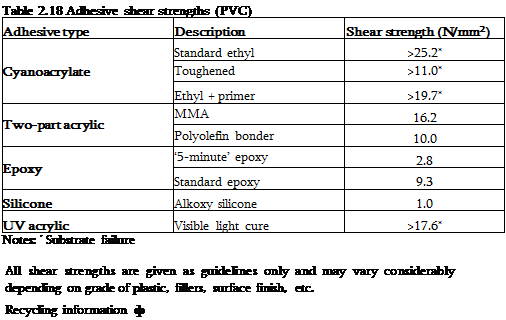Structural adhesives for plastics are more often than not epoxies, two-part acrylics, cyanoacrylates or UV-cure adhesives.
There are hundreds of different epoxy grades available and, whilst many of these are far more suited for bonding metals than thermoplastics, epoxies are used for some
 |
thermoplastic applications, especially if the gaps are relatively large or if the adhesive is to be used as a potting or encapsulation material as well as an adhesive. Epoxies will not bond to the non-polar plastics (polyethylene, polypropylene or the fluoropolymers but they do show good adhesion to ABS, polyamide, polycarbonate and other similar widely used materials. As a ‘rule of thumb’, the faster-curing (5-minute) epoxies often show lower strengths on plastics than the longer curing grades.
Two-part acrylics (or MMA) bond exceptionally well to many thermoplastics and these products are often used for the assembly of point-of-sale plastic assemblies where ease of application, strength and aesthetics are important.
Cyanoacrylates are probably the most versatile adhesives for the bonding of thermoplastics [3] as they are single-part, fast-curing adhesives with good strength and can offer excellent durability if the joint design and plastic grades are chosen carefully at the onset (see Section 7.2.2). Cyanoacrylates can be toughened and are particularly suitable for bonding rubber to plastics if over-moulding is not possible.
Cyanoacrylates are typically suitable for temperatures up to 100 °C, although some speciality cyanoacrylates are available for higher operating temperatures. One of the major benefits of cyanoacrylates is that they can be used (with a primer) to bond the non-polar plastics. More details about these primers are given in Section 6.2
and, although this primer makes the adhesive system two-part, it can be a lower cost method for production than an investment in other surface treatments such as plasma or corona treatment.
Cyanoacrylates are best suited where the gaps are small (<0.15 mm) and although some grades will fill bigger gaps there is always a risk of ‘blooming’ (see Section 10.2.6).
The three major benefits of UV-curing adhesives are the speed of cure, the optical clarity and the ‘cure on demand’. Although an investment in UV-curing equipment is required, these adhesives are successfully used on transparent substrates like polycarbonate and PVC [4].
 7 октября, 2015
7 октября, 2015  Pokraskin
Pokraskin  Опубликовано в рубрике
Опубликовано в рубрике 